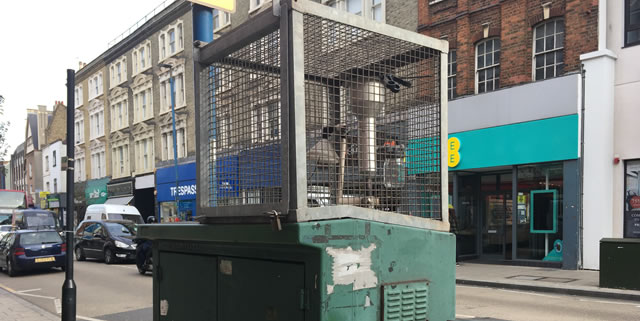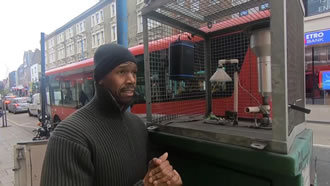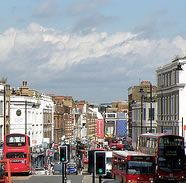Tackling Air Quality On Putney High Street
What residents think about one of London's most polluted roads

The air quality monitor on Putney High Street - image: Sian Bayley
Putney High Street is choc-a-bloc with buses and cars stopping and starting. It’s a major thoroughfare in the city, but its narrow size means that traffic tends to get congested.
It also means that pollution tends to hang in the air, contributing to its reputation as one of the most polluted areas in the capital.
In recent years levels of nitrogen dioxide and particles from exhaust fumes have dropped significantly because buses have been ‘retrofitted’ with new technology to their exhaust pipes, but pollution is still well above legal limits.
In Wandsworth Council’s most recent Air Quality Progress report, Putney High Street had an annual mean concentration of 68 micrograms per cubic metre (g m-3).
The EU legal limit is an annual average of 40 micrograms per cubic metre.
While this is a significant drop from 76 g m-3 in 2017, and a whopping 155 g m-3 in 2012, it still poses serious health risks.
According to Public Health England even short-term exposure to NO2 can lead to coughing and shortness of breath because it is a “respiratory irritant”.
Long-term exposure in children can cause reduced lung growth, and adults and older people become more prone to strokes, heart problems, diabetes and dementia.

image: Sian Bayley - Jonathan Callaway, Judith Chegwidden and Dr Richard Carter of the Putney Society
(l-r)
Judith Chegwidden, from the Putney Society, said she has noticed the improvements to air quality, but more still needs to be done. “You don’t smell it quite as often, but it’s not perfect, it’s way above the EU limit,” she said.
“Putney High Street is particularly bad because the prevailing wind across this county is from the west, and Putney High Street is very narrow, like a canyon, and goes north-south. So the dirty air sticks and circulates around.”
It is hoped that pollution will be further reduced once the Ultra-Low Emission Zone is extended to the South Circular, which is expected in October 2021.
On Monday (October 28) the Putney Society held a meeting about the new ULEZ plans, and were pleased to hear from Transport for London that NO2 emissions had been reduced by nearly a third in the city centre in just six months.
Resident Jonathan Callaway said Putney High Street “was a lot worse a few years ago” before the changes to the buses, and hopes the ULEZ will further improve things. But he said there were lots of local issues about plans for the ULEZ. Residents want to know what roads will be included and how it might be policed as the South Circular cuts across the area.
The ULEZ will go up to the South Circular, but not include the key route.
Drivers of most diesel cars and older petrol cars will have to pay £12.50 when they enter the zone, in addition to the weekday Congestion Charge if they drive in central London as well.
Mr Callaway said the society’s own air pollution mapping had found the crossing at the top of the high street, crossing the South Circular, was a hotspot for NO2 emissions.
Dr Richard Carter also warned that while he was glad to see more people opting for electric and low-emissions vehicles in the area, he was still concerned about the particulates released from brakes and tyres and people needed to be made more aware of the effects of air pollution.

images: Sian Bayley - David Smith
Wandsworth resident David Smith thought not enough was being done to reduce children’s exposure to air pollution. He runs Little Ninja UK, and campaigns for better air quality. He said the new low emission buses have stopped Putney High Street from being the most polluted road in the UK, but that NO2 levels are still dangerously high for children.
David Smith also thinks more needs to be done to improve the situation on nearby roads: “There are a number of roads close to Putney High Street where levels of pollution are arguably higher, like the Upper Richmond Road (South Circular) and West Hill (A3) but as air pollution on these roads are not measured there has been little action to reduce exposure for the residents, commuters and children who attend nursery and school on these roads.
“It’s time to broaden the focus from Putney High Street and measure air pollution on all the heavily congested roads in Wandsworth. It’s time to recognise the irreparable damage being caused every day to children’s lung and brain growth because they live, travel and attend schools on Wandsworth’s illegally polluted roads. It’s time to act and reduce children’s air pollution exposure.”
In their report, Wandsworth Council said they remain “committed to tackling air quality.” They aim to use petrol, hybrid and electric vehicles when replacing the council fleet “where possible,” and said all vehicles purchased under 1.205 tonnes “will not be diesel driven.”
They added that they have also conducted a number of anti-idling events, and undertake “proactive work with schools and measures taken to improve air quality, such as lobbying for cleaner buses, and the promotion of cleaner transport options such as river transport, 20mph zones, and electric cars.” But Dr Carter said it is going to be difficult to persuade people to make changes on their own, and that more legislation from government is needed.
Sian Bayley - Local Democracy Reporter
November 1, 2019
